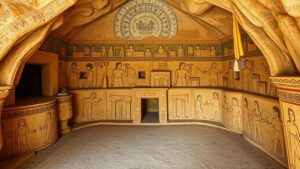Investigating tunnels that connect ancient temples over vast distances.
Investigating Tunnels That Connect Ancient Temples Over Vast Distances
The allure of ancient civilizations has long captured the imagination of scholars and adventurers alike. Among one of the most fascinating aspects of these ancient societies are the intricate tunnel systems that reportedly connect various temples over vast distances. These hidden passages not only reveal the architectural prowess of past cultures but also hint at deeper spiritual and cultural connections. This article delves into the investigation of these remarkable tunnels, examining their historical context, architectural significance, and the ongoing research surrounding them.
Historical Context of Ancient Tunnels
Tunnels connecting temples can be found in various cultures, from ancient Egypt to the Maya civilization. For example, the ancient Egyptian temple complex at Karnak, which dates back to around 2055 BC, features monumental structures with extensive networks of subterranean corridors. Similarly, the Maya civilization, thriving from 250 to 900 AD, constructed elaborate tunnel systems beneath their cities, including the impressive temple complex of Tikal in present-day Guatemala.
Architectural Significance
The design and construction of these tunnels illustrate the advanced engineering skills possessed by these ancient cultures. Most notably, the tunnels often featured:
- Complex Structural Designs: Archaeologists have discovered that many tunnels were not simply straight passages but included sharp turns and strategic openings revealing hidden chambers.
- Incorporation of Natural Elements: Many tunnels leveraged the natural landscape, using geological formations to facilitate construction and structural stability.
For example, the subterranean temple complex of Derinkuyu in Cappadocia, Turkey, excavated around the 8th century BC, showcases a multi-level structure that could house thousands of people. The design included ventilation shafts and water wells, demonstrating sophisticated planning and an understanding of engineering principles.
Spiritual and Cultural Connections
The existence of these tunnels often hints at deeper spiritual significance. In many ancient cultures, temples were seen as gateways to the divine. Tunnels allowed for ceremonial processions and secret rituals, fostering a network of belief systems across great distances. For example, in the ancient city of Teotihuacan in Mexico, a series of tunnels known as the Avenue of the Dead connected the Temple of the Sun and the Temple of the Moon, mostly believed to serve interconnected religious functions.
Modern Investigations and Discoveries
Modern investigations into these ancient tunnels involve a combination of archaeology and technology, including ground-penetrating radar (GPR) and 3D mapping. In recent years, significant findings include the discovery of extensive tunnel networks beneath the Temple of Kukulcán at Chichén Itzá, Mexico, which date back to the Maya civilization. Researchers uncovered paths that could link multiple sacred sites, revealing a staggering level of urban planning and cultural connectivity.
Also, the exploration of the subterranean systems in the catacombs near Rome, Italy, has highlighted the role of tunnels in early Christian practices, with evidence suggesting that they were used as refuge during periods of persecution. This illustrates how tunnels served not only as physical connections but also played crucial roles in the spiritual and communal aspects of ancient societies.
Real-World Applications of Tunnel Research
The exploration of these ancient tunnels contributes valuable insights into various fields such as:
- Archaeology: Discovering new sites can lead to a better understanding of ancient cultures, their rituals, and their everyday lives.
- Engineering: Studying ancient construction techniques can inform modern engineering practices, particularly in areas prone to earthquakes or erosion.
- History: Insights gained from these tunnels illuminate the interconnectedness of ancient civilizations, reshaping our understanding of cultural diffusion.
Conclusion and Actionable Takeaways
Investigating ancient tunnels that connect temples opens a window into the advanced capabilities and rich cultural practices of historic societies. As research continues to unfold, it is essential to recognize the value these discoveries hold for modern science and our understanding of human history.
For those interested in exploring this fascinating topic further, consider visiting archaeological sites, engaging with local historians, or participating in archaeological digs. Also, support and follow global heritage preservation organizations that aim to maintain these invaluable sites for future generations.



